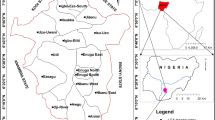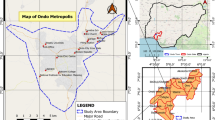Abstract
The vulnerability evaluation of regional geo-environment is a important tool for geo-environmental protection and management, and provides scientific basis for decision makers on the regional development planning in the future. This paper presents a first attempt to construct a prototype framework that can evaluate geo-environment vulnerability with the aid of spatial analysis tool of GIS and the analytical hierarchy process (AHP). Proposed framework is significant tool in the complicated evaluation process of geo-environment vulnerability. Moreover, a new method, named the AHP—index accumulation method (IAM)—difference method, is proposed to evaluate geo-environment vulnerability. This method can provide help for other studies on geo-environment vulnerability evaluation. The major results are as follows: high vulnerability zone accounts for 2.5% of the total study area, where over-exploitation of groundwater causes seawater intrusion; medium vulnerability zone accounts for 39.4%, and located in Wujia Town, Shiwan Town, Datianping Village, Hepu County, Zhakou Town and Gongguan fault belt, where collapse and landslide are likely to occur, seawater intrusion is more prone to occur in Nangkang Basin, collapse and seawater intrusion are more prone to occur in Weizhou Island; the remaining areas is under the low vulnerability and stable area, accounting for 58.1%. Based on the results of vulnerability evaluation, three protection districts and corresponding protection recommendations are proposed for geo-environmental protection and management. The vulnerability map is significant to land use planning and environmental management.






























Similar content being viewed by others
References
Corominas J, van Westen C, Frattini P et al (2013) Recommendations for the quantitative analysis of landslide risk. Bull Eng Geol Env 73(2):209–263
Cui AP (2004) Geological hazard zoning in Lueyang by information system spatial analysis and harassing coefficient method. J Catastrophol 02:53–57 (in Chinese)
DD2015-02 (2015) Code for evaluation and evaluation of active faults and regional crustal stability. China Geological Survey, Beijing (in Chinese)
Gonzalez P, Neilson RP, Lenihan JM, Drapek RJ (2010) Global patterns in the vulnerability of ecosystems to vegetation shifts due to climate change. Global Ecol Biogeogr 19(6):755–768
He J, Li QH, Liu HQ, Yu SW, Huang GB, Huang DS (2015) Review on the main geological environmental problems in Beibu Gulf Economic Zone. Geol Miner Resour S China 31(1):96–103
He L, Shen J, Zhang Y (2018) Ecological vulnerability assessment for ecological conservation and environmental management. J Environ Manage 206:1115–1125
Hou JD, Lv J, Chen X, Yu SW (2016) China’s regional social vulnerability to geo-hazards: evaluation and spatial characteristics analysis. Nat Hazards 84:97–111
Huang YZ (2010) Reserch on the vulnerability of geological environment and its Countermeasures in Lijiang. Kunming Univ Sci Technol Yunnan (08): 64–65 + 73 + 119 (in Chinese)
Janssena MA, Schoon ML, Ke W, Börner K (2006) Scholarly networks on resilience, vulnerability and adaptation within the human dimensions of global environmental change. Glob Environ Change 6(3):240–252
Kuang H, Ma CM, He ZK (2016) The geo-environmental risk assessment of Kaifeng City based on the urban planing. Enviro Eng 02:133–137 + 132 (in Chinese)
Liang H, Zhou AG, Tang ZH (2010) Evaluation and division of geological environment for urban construction land. China University of Geosciences, Wuhan (in Chinese)
Maru YT, Smith MS, Sparrow A, Pinho PF, Dube OP (2014) A linked vulnerability and resilience framework for adaptation pathways in remote disadvantaged communities. Global Environ Change 28:337–350
Mavromatidi A, Briche E, Claeys C (2018) Mapping and analyzing socio-environmental vulnerability to coastal hazards induced by climate change: an application to coastal Mediterranean cities in France. Cities 72:189–200
Ministry of land and resources of the People’s Republic of China (2014) Specification of comprehensive survey for landslide, collapse and debris flow
Saaty TL (1980) The analytic hierarchy process for decision in a complex world. RWS Publication, Pittsburgh
Saaty TL (2004) Decision making—the analytic hierarchy and network process (AHP/ANP). J Syst Sci Syst Eng 13(1):1–35
Stevenazzi S, Bonfanti M, Masetti M, Nghiem SV, Sorichetta A (2017) A versatile method for groundwater vulnerability projections in future scenarios. J Environ Manag 187:365–374
Sun Y, Tan CX, Tang GS (1997) Quantitative evaluation and zonation of regional crustal stability in China. J Geomech 03:11 (in Chinese)
Tang CH, Zhou RL (1994) Present situation of geological environment and geological hazard in coastal area of Beibu Bay, Guangxi. Bull 562 Compr Geol Brigade Chin Acad Geol Sci 00:55–72 (in Chinese)
Yang L, Peng HY, Zhou ML et al (2004) Evaluation of geological environment carrying capacity of Fengjie County based on analytic hierarchy process. J Chongqing Jiaotong Univ (Nat Sci) (02): 95–99 (in Chinese)
Yao X (2014) Development and problems of regional crustal stability assessment study companying with discussion of the specification compilation. Geol Rev (01): 22–30 (in Chinese)
Yu CS (2007) A survey on progress of environmental vulnerability research. Water Resour Power (04): 23–27 (in Chinese)
Zheng CY, Zhang QX, Jia J (2010) Application of analytic hierarchy process in source region of Yangtze River’s geological environment quality (vulnerability) evaluation. Northwestern Geol (01): 137–145 (in Chinese)
Zhou X, Chen MY, Wan L, Wang JP, Ning XS (2010a) Optimal groundwater development in coastal aquifers near Beihai, China. J China Univ Geosci 11(3):334–340
Zhou X, Chen MY, Ju XM, Ning XS, Wang JP (2010b) Numerical simulation of sea water intrusion near Beihai, China. Environ Geol 40(1–2):223–233
Author information
Authors and Affiliations
Corresponding author
Additional information
Publisher’s Note
Springer Nature remains neutral with regard to jurisdictional claims in published maps and institutional affiliations.
Rights and permissions
About this article
Cite this article
Ma, C., Wu, X., Li, B. et al. The vulnerability evaluation of regional geo-environment: a case study in Beihai City, China. Environ Earth Sci 78, 129 (2019). https://doi.org/10.1007/s12665-019-8077-7
Received:
Accepted:
Published:
DOI: https://doi.org/10.1007/s12665-019-8077-7




